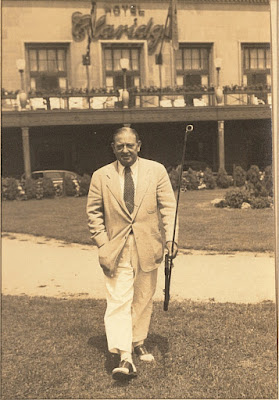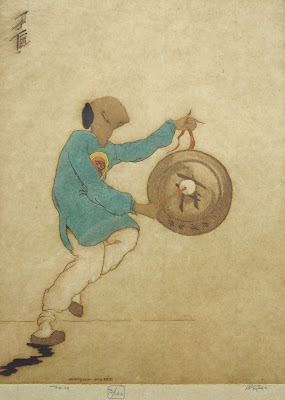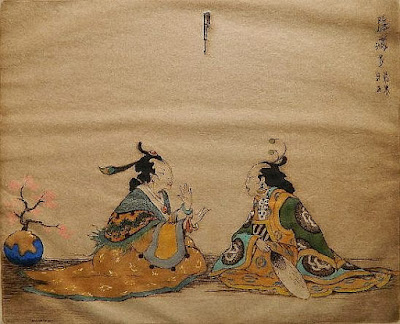After hours of Internet sleuthing, I learned that Tyson was the son of Caleb
Dorsey Tyson, a clerk and later salesman of cement and building supplies, and
Lillian Potter. He was often
mistakenly referred to as “Dorothy” Tyson, a fact which no doubt contributed
to his decision to be called “Pete” or “Petey” by close friends. Tyson
graduated from Baltimore City College in 1911, where he appears to have
studied law, although it is not clear that he ever sat for the bar. He was elected the Law Department’s class secretary and was also designated
the class artist, all the while working at the Title Guarantee and Trust
Co. According to his WWI draft
card, by 1917 he was a clerk at the Fidelity Trust Company in Baltimore and
said to be of medium height and build with blue eyes and slightly balding
brown hair. It appears that he
was stationed on Long Island during the Great War but apparently never served
in combat. The following year he married Caroline (“Kitty”) Polk of Baltimore,
Maryland. According to the 1920
federal census, he was listed as living on the Upper West Side of New York
City and working for a brokerage firm as well as living at his parents’ home
in Baltimore where he was listed as a bond salesman. He also appeared in the 1922 edition of Investment Bankers and Brokers of
America working for the Investment Registry of America, Inc. in Baltimore
as the Manager of their Philadelphia branch.
Ex Libris for William E. Bauer (1926) by Dorsey Potter Tyson
(etching)
Near as I can determine, Tyson’s earliest etching dates to 1926, an ex libris
for William E. Bauer. Bauer's identity and relationship to Tyson is not
currently known, but the most likely candidate was a identically-named
gentleman who was involved in lending maps and pictures of Baltimore to be
used as illustrations for "Baltimore: A Not So Serious History" (1928) by
Letitia Stockett. If so, he might have been a local patron of Tyson, as
many of Tyson's early etchings were scenes of Baltimore. Starting in
1928, however, Tyson began to make his art deco-styled colored etchings of
Asian (and usually predominantly Chinese) scenes. One can only assume that he took his cue from Elyse Lord’s popularity in this
genre and, probably for that reason, he enjoyed a strong English following for
his work.
Washington Monument (1927) by Dorsey Potter Tyson
(archive photo of etching)
By 1930, Tyson and his wife were still living with his parents, but his
occupation in the 1930 federal census was listed as an “engraver,” which
suggests that he was now a full-time artist. The Depression, however, was very hard on most etchers, and it appears that
Tyson was no exception. England originally had been a major market for
Tyson's prints, but those sales dried up by the early 1930s when Great Britain
imposed a fifty percent import duty on such works. Although not all of Tyson’s etchings are dated, the latest example I’ve found
is dated to 1934 and the latest scored plate I’ve found was cancelled in
1938. By 1940, the federal
census reports Tyson as living in an apartment in Baltimore
(with his widowed mother living in the apartment next door), an apartment
which he had been renting for at least 5 years. No occupation is listed and it appears that he was unemployed at the time.
Dragon Boat Festival (1929) by Dorsey Potter Tyson
Courtesy of The Art of Japan
(etching)
Courtesy of The Art of Japan
(etching)
Unfortunately, federal census records after 1940 are not yet available to the
public. Tyson’s 1942 WWII draft
registration card has him listed as being self-employed and living in Ruxton,
a section of the Towson suburb in Baltimore County. It is known that Tyson was a dog fancier, particularly of spaniels. As early as 1917 he had an Airedale Terrier listed in the American Kennel
Club stud book. He was approved
to judge for the AKC English Setters and certain spaniel breeds in February
1938 and for Maltese and Pekinese dogs in 1943. Newspaper articles mention him judging toy dogs into at least the early
1950s. Tyson was also friends
with the etcher and fellow dog breeder/judge Marguerite Kirmse and her husband
George W. Cole. Thanks to an
introduction by Kirmse, Tyson designed a bronze terrier sculpture for the
Gorham Foundry in the mid-to-late 1930s, similar to a series of bronze
Scotties that Kirmse had designed several years earlier for Gorham.
Patsy (Sussex Spaniel) (copyrighted March 31, 1931) by Dorsey Potter Tyson
Courtesy of MissMadisons.com
Courtesy of MissMadisons.com
(bronze sculpture)
Not much else is known about Tyson’s later life except that he executed a
number of gouache and colored pencil works collectively known as the
“Pixiecraft Collection” that were used for a series of covers for Poodle
Showcase magazine circa 1964-1969. These whimsical covers featured poodles dressed as people engaging in a
variety of activities such as playing golf or skiing. It’s possible that Tyson worked as an illustrator prior to 1964 for other
publications, but such freelance work is as yet undocumented.
Cover designs for Poodle Showcase magazine (c. 1964-1969) by Dorsey Potter
Tyson
(gouache and colored pencil)
(gouache and colored pencil)
It is Tyson’s art deco colored etchings, however, for which he is
largely remembered today. His
standard technique for producing such colored etchings was rather
unusual. They were not
handcolored, as Charles W. Bartlett’s etchings were. Their colors were also not applied by woodblocks, the method often employed
by Elyse Lord. Nor were these
prints mezzotints or aquatints. The English print dealer Michael Campbell of Campbell Fine Art has made a
detailed analysis of Tyson’s prints and determined
that “[t]hey are in fact, the result of skillful colour printing alone,
using a technique which effectively combines the printing of a normal
etching simultaneously with that of printing a monotype. The lines of the etched design, which compose the basic image are inked
with black printer's ink, and the surface of the plate is then cleaned in
the manner used for printing a normal monochrome etching. Thick, coloured printer’s inks are then painted onto the surface of the
plate using a brush as though painting a plate for a monotype printing; the
proof is then printed at one pull through the press.” This is a time-consuming alternative to applying color “à la poupée,” and was a “technique was being used in England on single metal
printing plates in one printing by the Detmold twins from the 1890’s through
until the 1920’s (by the surviving brother) and on multiple metal printing
plates in multiple printings by William Giles.”
There is, as yet, no catalogue raisonné for Tyson’s prints, so the following
list is undoubtedly incomplete. If a reader is aware of a missing design, please let me know and I will add
it to the list. Tyson’s etchings
are sometimes, though not always, hand-titled in pencil. Fortunately, the original labels for many of his etchings have survived to
supply authoritative titles that might missing from the prints
themselves. Nonetheless, some of
the reported titles by certain dealers and auction houses appear to be
unofficial, descriptively-attributed ones.
The dating of Tyson’s prints can also sometimes be problematic. In some cases, the creation date is noted in the plate itself. However, such dates are almost microscopically small and often illegible in
most on-line images. In other
cases, Tyson helpfully hand-noted the date in Roman numerals in pencil. But no date is readily apparent for a number of his designs. I’ve listed his color prints chronologically, with those that are undated or
with illegible dates last. If a
reader has ready access to any of his prints and can date a given design (or
correct the date for a given design), let me know and I’ll put the print in
its proper place.
Restrikes of at least some of Tyson's etchings were made in the 1970s after Tyson's death. Absent a label to that effect, it is not known at this time how the restrike etchings can be distinguished from the original etchings. The mat for one of these posthumously-printed etchings bears the name of the Marson Ltd. Gallery, but that may have been the name the framer, and not the publisher of the restrike etching.
Unless otherwise indicated, the following etchings are all in color and have an edition size of 100.
1. Ex libris William E. Bauer, black and white etching, edition unknown.
6. University of Maryland School of Medicine, dated "28" in plate, edition unknown.
7. Village, etching in sepia, original edition unknown; restrike edition of 100 made in 1974.
1929
Restrikes of at least some of Tyson's etchings were made in the 1970s after Tyson's death. Absent a label to that effect, it is not known at this time how the restrike etchings can be distinguished from the original etchings. The mat for one of these posthumously-printed etchings bears the name of the Marson Ltd. Gallery, but that may have been the name the framer, and not the publisher of the restrike etching.
Unless otherwise indicated, the following etchings are all in color and have an edition size of 100.
1926
1. Ex libris William E. Bauer, black and white etching, edition unknown.
[See image above]
1927
2. Washington Monument, black and white etching, edition of 300.
View taken from the southwest corner of Mt. Vernon Place.
[See image above]
3. Washington Monument Looking North, black and white etching, edition
unknown.
1928
4. North Avenue Viaduct & Mt. Royal Pumping Station, assumed to be a
black and white etching, edition unknown.
5. Old Gay Street [Baltimore Skyline from the Northeast], assumed to be a black and white etching, edition unknown.
5. Old Gay Street [Baltimore Skyline from the Northeast], assumed to be a black and white etching, edition unknown.
6. University of Maryland School of Medicine, dated "28" in plate, edition unknown.
7. Village, etching in sepia, original edition unknown; restrike edition of 100 made in 1974.
8. Chinese Study #1, edition assumed to be 100, plate cancelled.
9. Chinese Study #2, dated "28" in plate, edition assumed to be 100, plate
cancelled.
10. Dancer #1, edition assumed to be 100. Note: I have not
found any record of this print, but the existence of "Dancer #2" suggests
that such a print was made by Tyson. It is also possible that this is
the same print as "The New Dance" below.
11. Dancer #2, edition assumed to be 100.
12. Feast of Lanterns
13. Gossip, plate cancelled.
14. The Head Dress
Courtesy of Campbell Fine Art
15. Junks and Coolies, plate cancelled.
16. Siamese Dancers
17. Song of the Wood Wind
1929
18. Hanover St. Bridge, assumed to be a black and white etching, edition
unknown.
19. A Chinese Gong
20. Dragon Boat Festival
[See image above]
21. Loading Junks, dated "29" in plate, plate cancelled January 1933.
Courtesy of the TOJ Gallery
22. North Gate, dated "9/29" in plate.
23. Peacock Fan (aka My Peacock Fan), dated "29" in plate, plate cancelled May
18, 1934.
24. Puppet Show, dated "6-19-29" in plate.
25. The Snow Maiden
Courtesy of Frazer Fine Art
26. Sword Dance
1930
27. Baltimore Cathedral, black and white etching, edition unknown.
Note: This etching, published by the Purnell Galleries, was commissioned as a Maryland Chapter Souvenir of the Ninth Biennial Convention of the International Federal of Catholic Alumnae, August 1930.
28. Bright Sails, dated "30" in plate, only 86 proofs were made, plate cancelled March 1, 1938.
Courtesy of the TOJ Gallery
29. Chinese Study #3, dated "1-2-30" in plate, plate cancelled June 30, 1938.
Note: This color variant is dated "11-1-30" in plate:
30. Chinese Study #4, dated "10-30-30" in plate.
30. Chinese Study #4, dated "10-30-30" in plate.
31. East Wind, dated "4-22-30" in plate.
32. Joy Ride, dated "11-8-30" in plate.
33. Mother and Child, edition assumed to be 100.
36. A Princess, dated "2-9-30" in plate, plate cancelled March 17, 1937.
37. The Temple
38. Untitled [Asian Woman]
1931
39. The Coolie, dated "31" in plate, plate cancelled June 30,
1938.
40. Jade Market, dated 4-31 in plate.
Courtesy of The Art of Japan
41. Market Day
43. Spring Rain, dated "6-26-31" in plate.
1932
44. At Bay, dated "1-2-32" in plate, plate cancelled June 30, 1938.
45. Brush Boat
46. The Concert
47. Dawn, dated "8-19-32" in plate.
48. The Favorite (aka The Singing Geisha), dated "9-12-32" in plate.
49. Flower Basket
50. Jewel Box
51. Nomads, dated "8-12-32" in plate, plate cancelled January 3, 1935.
52. Secrets
53. [Kite Flying], dated "9-22-32" in plate
1933
54. Blossoms (aka Gathering Blossoms)
55. Dance of the Dreams
56. Lacquer Bridge
57. The Offering
Unknown Dates
58. Baltimore Skyline from the Northeast, presumed to be a black and white etching, edition unknown.
59. Basilica of the Assumption, presumed to be a black and white etching, edition unknown.
60. The Bridge [aka New York From Brooklyn], etching in sepia?, edition unknown.
61. The Bridge (possibly a descriptive title), black and white etching, edition unknown. Note: Could this be the Pont Neuf in Paris?
Courtesy of Mills College Art Museum
62. West Biddle Street, presumed to be a black and white etching, edition unknown. Note: There is an untitled print of a street in the Maryland Historical Society archives dated 1928 and of an edition of 100 which is possibly this print.
63. The Bridge
64. China Bridge, plate cancelled December 23, 1933.
65. The Circus, edition assumed to be 100.
66. Goose Boy
67. The Jinrikishaw (aka Rikishaw)
68. Moon Maid, edition of 100, plate size 9-3/4" x 11-3/4"
70. The New Dance
Courtesy of The Art of Japan
71. Orange Sails
Courtesy of the Edward T. Pollack Fine Arts
72. Plum Blossom
(color variant)
73. River Traders
74. Sing Song Boat
75. Tea Time
Courtesy of Campbell Fine Art
76. Snag (aka Tangled)
77. Untitled [Water Gate #2?], edition assumed to be 100. Note: In lieu of an image of the colored print, I have shown a black and white print taken from the plate. Given that the plate was not cancelled at the time that the print was made, it is possible that less than 100 proofs were made, or that the design was never commercially issued.
78. Vanity
79. Water Gate
80. Unknown "S.P.Q.R." design
Note: This etching is known only from Tyson's plate and may not have finished or ever commercially issued. It shows an Erte-type flapper near a crest bearing the initials "S.P.Q.R." (the Latin initials for Senatus Populusque Romanus (The Senate and the People of Rome).
81. Untitled [Couple under an Umbrella]
Courtesy of a Private Collector
Note: This etching is known only from Tyson's plate and may not have finished or ever commercially issued. It shows an Erte-type flapper near a crest bearing the initials "S.P.Q.R." (the Latin initials for Senatus Populusque Romanus (The Senate and the People of Rome).
81. Untitled [Couple under an Umbrella]
82. [The Archer]
83. Untitled [People, a Boat, and Lanterns] (Test Print)
Courtesy of Moonlit Sea Prints
I'm also aware of another Tyson design but the details concerning its medium
are murky. I'm told that the first work below appears to be a
photograph (presumably of a drawing or uncolored test etching) with a little
bit of white paint applied, and that the second is a fully hand-colored copy
of the same photographic image. Bertha Lum is known to have produced
similar types of works. Perhaps this was Potter's way of planning out
the colors for his etchings, or maybe it was his way to generate additional
income once the original edition was completed and his plates had been
scored. In fact, the second work is illogically numbered
"215/100." Could this mean that at least an additional 115 of these
mixed media pieces were created outside of the edition of the 100?
Whether Potter commercially issued etchings based on this design is not known
at this time, but it does not seem illogical to assume that some might have
been.
Mixed media work ["Tea"] with test color added by hand
Courtesy of Geoffrey Oliver
Mixed media work ["Tea"] with extensive hand-coloring
Courtesy of Geoffrey Oliver
The University of Baltimore Langsdale Library, was at one time, in possession of
23 prints taken from (mostly) cancelled plates by Tyson (and possibly the plates
as well). However, at some point
prior to 2013, these prints were destroyed. A visual record of 20 of those prints can, at least for the time being, be
found on a prior incarnation of the University of Baltimore website. http://archives.ubalt.edu/print/pdf/tyson.pdf The location of Tyson’s plates
are largely unknown, although a few turned up for sale at a Maryland auction a
number of years ago (including at least three of the plates used to make some of
the Langsdale Library's prints).
Dorsey Potter Tyson in Atlantic City (c. 1950s?)
Courtesy of Geoffrey Oliver
If a comment box does not appear below, click on this link instead: http://easternimp.blogspot.com/2016/02/asian-art-deco-1-dorsey-potter-tyson.html
























































































